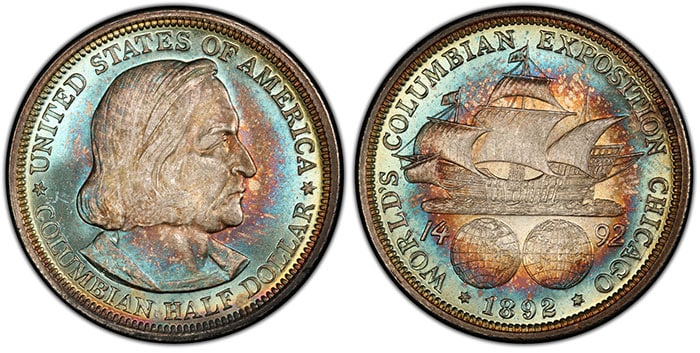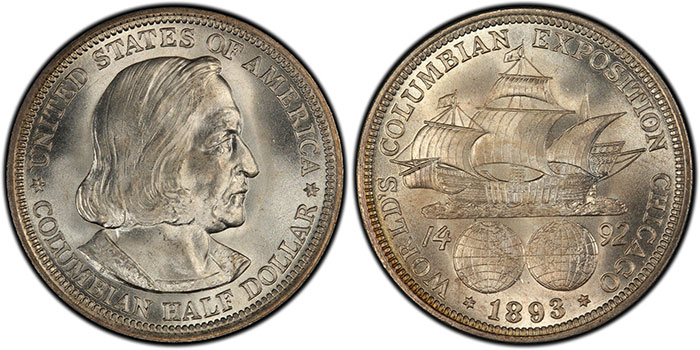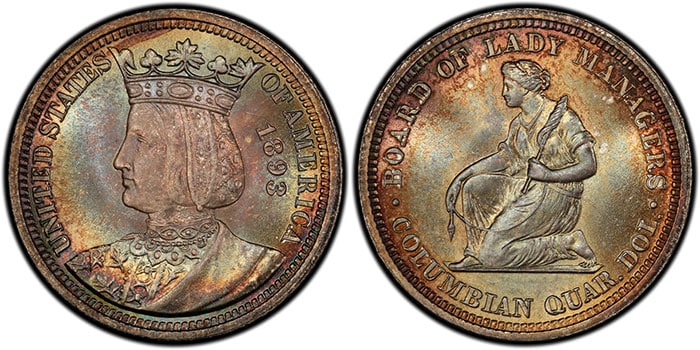By Victor Bozarth for PCGS ……
While some recognize the 1848 CAL Quarter Eagle struck from California gold as the first United States commemorative coin, it wasn’t until 1892 that the United States Mint began producing coins broadly classified as commemorative coins. The first of these were produced and sold in 1892 in conjunction with the Columbian Exposition held the following year. The 1892 Columbian Exposition Half Dollar was the first of many dozen commemorative coins struck through 1954.

A trio of commemoratives was struck in concert with the Columbian Exposition, including the 1892 Columbian Exposition Half Dollar, the 1893 Columbian Expo Half Dollar, and the 1893 Isabella Commemorative Quarter. They mark both the 400th Anniversary of Christopher Columbus’ voyage to the “New World” in 1492 and the Columbian Exposition, which was held in Chicago, Illinois, from May 1 to October 30, 1893.
The Windy City Lands Its Fair
A bitterly contested battle between the leading U.S. cities of the day, including Chicago, New York City, St. Louis, and Washington, D.C., played out on February 24, 1890, when Congress secured a majority of 157 votes (they needed 154) backing Chicago as the choice for what would become the Columbian Exposition. Congressman Robert Hitt (R-6) of Illinois led the charge for Chicago, but massive fundraising efforts spearheaded by Marshall Field were crucial, too. Chicago’s vast railroad network in addition to backing by these railroad and other business magnates, especially meat-packing plant owners, assured the U.S. that Chicago would make a fine host city.
World Fairs were a big deal. In 1851, The Great Exhibition, or Crystal Palace Exhibition, held in Hyde Park in London, was quite successful. Organized by Henry Cole and Prince Albert, husband of Queen Victoria, it was the first of many World’s Fairs to follow, exhibiting educational, cultural, and industrial advances. Everybody loves a fair, but certainly just the vast accumulation of knowledge and industry in one place on a periodic basis available for the world to see made sense.
In 1889, the Exposition Universelle was held in Paris, France. Gustave Eiffel’s tower created for the exposition ushered in an era of sensationalism as a draw to the format of future World Fairs. By the late 1880s, there was a growing groundswell of interest in holding a World’s Fair in the United States to rival those held in both London and Paris.
The host of a Fair in the U.S. hoped to glamourize their cities in the eyes of the world like both London and Paris had successfully done with their World’s Fairs. Why wouldn’t New York City, Chicago, St. Louis, and Washington D.C. want to host one, too?
Minting A Success
The Columbian Exposition spurred our nation’s first two commemorative half dollars and our only classic commemorative quarter dollar. Just over 2.5 million total half dollars were minted and dated 1892 and 1893 with mintage totals of 950,000 and 1,550,405, respectively. Approximately 100 brilliant Proofs of each date were struck also.

The Columbian Half Dollar design was by Olin L. Warner. Charles Barber engraved the obverse design and George Morgan engraved the reverse. Mint State examples of the half dollars were sold at the fair for $1 each, but many remained unsold and were either put into circulation at face value or melted at a later date.
Fair Fight
The 1893 Isabella commemorative quarter is special. Issued at the behest of the Board of Lady Managers, this coin was designed by Charles Barber. Also sold for $1 each, many of the 24,214 coins minted remained unsold after the fair. Regardless, with a total production of fewer than 25,000 coins, Isabella Quarters have always been desirable.

During this pivotal era of women’s suffrage, the Board of Lady Managers was to a certain extent, a counsel, sanctioned by Congress to control how women would be involved in the fair. The “Board” platform was to display civility to the public, but immediately there were conflicts between various women’s groups with varying opinions to be represented at the fair. Interestingly, one of the groups most opposed to the generally held conventions of the Board of Lady Managers was The Isabella Association. The majority of these women were suffragists fighting for the vote versus just reform. While the Board of Lady Managers advocated a separate Woman’s Pavilion to separate women’s contributions, the Isabella’s rejected the Women’s Pavilion idea and advocated for the inclusion of women’s achievements in all exhibitions at the fair.
Indeed, the whole point of their argument was that the entire fair itself – the Columbian Exposition – was at the behest and funding of Queen Isabella in the first place.
Regardless, the seeming job of Bertha Palmer, appointed President of the Board of Lady Managers, was to prevent the Isabellas from achieving their aims with the exposition. While we have Palmer to thank for the Isabella Quarter, she ruled the Board of Lady Managers with no dissent. Phoebe Couzins – an Isabella, the appointed Secretary of the Board – clashed with Palmer and other board members and was removed from her position. Palmer’s goal of presenting a united front to the public failed.
Fair Fight indeed.
* * *






BEHEST, not bequest!